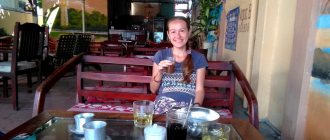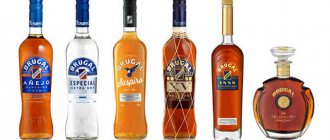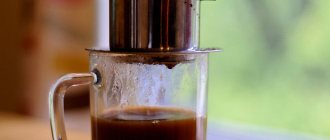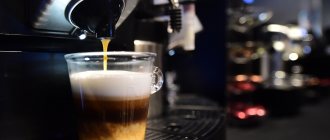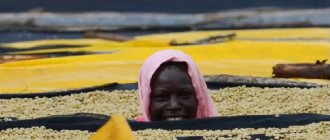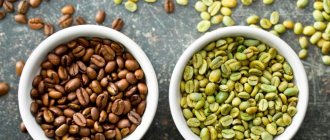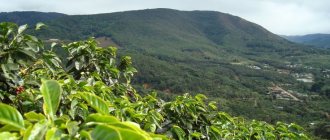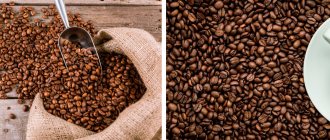Vietnamese coffee a truly delicious drink that will give you a thousand different tastes. Tourists in Vietnam can easily buy all varieties and kinds Vietnamese coffee in decent specialized supermarkets, as well as thousands of street stalls. Which Vietnamese coffee varieties There are also the most popular cooking recipes, we will consider below.
General information
The coffee boom in Vietnam began in the mid-19th century. Coffee trees were brought to the country by French missionaries.
Over time, Europeans came to realize that the mild climate and geographical location of the country were excellent for growing coffee.
In the late eighties of the 19th century, coffee was grown en masse in the state. Especially in Nge An province. It was there that the largest coffee plantations appeared.
Location on the map of Nge An Province
In the first half of the twentieth century, the cult of the strong drink spread to the Tai Nguyen plateau. Then the Europeans organized the cultivation of coffee in the central mountainous areas of the country.
The best Vietnamese aromatic grains are grown there today.
How has coffee impacted Vietnam's economy?
Around the world, when you think of coffee, you probably immediately think of Brazil, Colombia or, perhaps less commonly, Ethiopia.
But the second largest exporter in the world today is Vietnam. The country's market share has grown from 0.1% to 20% in just 30 years, and these rapid changes have impacted the country's economy.
Until the 1990s, there was little financial incentive for farmers to stop growing robusta because the Vietnamese government bought the entire coffee crop at a fixed price. With the opening of the private market, everything changed.
When the Vietnam War ended in 1975, the country was on its knees, and economic policies copied from the Soviet Union did not help. The collectivization of agriculture was a disaster, so in 1986 the Communist Party made a U-turn—betting big on coffee. Coffee production then grew by 20-30% every year in the 1990s.
Currently, the industry employs about 2.6 million people. Moreover, coffee beans are grown on half a million small farms ranging from two to three acres each.
This helped transform the Vietnamese economy. In 1994, about 60% of Vietnamese lived below the poverty line, now less than 10%.
Coffee was introduced to Vietnam by the French in the 19th century, and by 1950 the country already had an instant coffee factory in operation. This is how most Vietnamese coffee is consumed, which is partly why around a quarter of the coffee consumed in the UK comes from Vietnam.
Some companies, such as Nestle, have processing plants in Vietnam that roast the beans and package them.
But Thomas Kopple, an economist at the International Coffee Organization in London, says most are exported as green coffee and then processed elsewhere, such as Germany. While a large number of Vietnamese make a living from growing beans, some have become wealthy in the coffee business.
at the World Coffee Museum
Take, for example, multimillionaire Dang Le Nguyen Vu. His company, Trung Nguyen Corporation, renamed Trung Nguyen Legend Group in 2016, is based in Ho Chi Minh City, formerly Saigon. But its wealth is made in the Central Highlands around the town of Buon Ma Thuot, the country's coffee capital.
Chairman Wu, as he is nicknamed, owns five Bentleys and ten Ferraris and Forbes magazine estimates his wealth at $100 million. And this in a country where the average annual income is $1,300.
Dang Le Nguyen Vu
At the same time, some members of Vietnam's ethnic minorities say they have been driven off their land because of coffee farming.
But the multimillionaire says coffee is good for Vietnam. He plans to create an international chain of Vietnamese-style coffee shops.
“We want to introduce Vietnamese coffee culture to the whole world. It won't be easy, but we want to compete with big brands like Starbucks. If we can conquer the US market, we can conquer the world,” he says.
The museum stores more than 10,000 exhibits
However, expanding coffee fields also has its drawbacks. Agricultural activities of any kind pose hidden dangers in Vietnam due to the huge amount of unexploded ordnance left over from the Vietnam War.
In one province, Quang Tri, 83% of fields are believed to contain bombs. Environmentalists also warn that disaster is looming.
WWF estimates that 40,000 square miles of forest have been cleared since 1973, including for coffee farms, and experts say much of the land used for coffee cultivation is steadily depleted.
“Vietnamese farmers use too much water and fertilizer,” says Dr Dave D'Haze, a Belgian soil expert. “There is a traditional belief that you have to do this, and no one has been trained how to grow a coffee tree properly.”
The most popular recipes in the country
The features of preparing the drink look like this:
- A portion of coffee is prepared by passing it through a filter.
- The Vietnamese do not wait for brewing; they prefer to prepare the drink at the table.
- To make the coffee sweeter, condensed milk is used.
The use of condensed milk instead of regular milk is due to climate conditions. Over time, this method of brewing the drink contributed to a change in the taste preferences of the country's residents.
Ice + milk = Ca fe sua da
For preparation, high-quality ground coffee, condensed milk, granulated sugar, ice and water are used.
Ca fe sua da
Accessories:
- Vietnamese coffee maker.
- Cup for ice cubes.
- A glass for preparing a strong drink.
The “trick” is that boiled coffee should settle as the top layer in a glass with milk already poured. Then ice cubes are added to the container.
Before preparing coffee beans, they are highly ground. The grind should be very fine. The proportions with condensed milk are 1:1 (2-4 tsp of both). Additional ingredients: granulated sugar (if desired), water, ice.
Coffee according to this recipe is also brewed using a special Vietnamese filter.
Kopi Luwak - a drink made with musanga
The process of making luwak coffee from animal feces in Vietnam is specific and exotic. It involves the musanga, a small, cute animal that resembles a marten.
Musang
First it eats coffee cherries. After defecation, the coffee beans are collected, washed thoroughly, and then roasted.
The drink prepared in this strange way has a unique aroma and a more delicate, rich taste.
Yogurt coffee
It is a combination of coffee and yogurt mixed together. The bitter drink goes well with the delicate taste of the creamy paste. It is best to combine mango yogurt and any coffee.
Ca phe sua chua
Ca phe sua chua is prepared very simply: thick yogurt is mixed with black coffee.
Egg coffee
In the north of the country, egg coffee is extremely popular. The Vietnamese name is Ca phe trung. The drink is better known to tourists as Egg coffee.
Can be served both hot and chilled. Hot is poured into a ceramic container. The glass is placed in a large bowl of hot water.
Ca phe trung
The taste of the beaten egg is reminiscent of creme brulee.
Serve chilled in a glass container with ice cubes.
You can't mix it. First you need to eat an egg, only then drink a drink.
Coffee + banana + avocado
Tourists visiting Hanoi and Ho Chi Minh City are advised to enjoy Sinh to ca phe chuoi bo. This is a coffee smoothie made from an aromatic drink, banana and avocado.
The uniqueness lies in the fact that it combines the “incompatible”: caffeine and vitamins.
Exotic "fin"
The Vietnamese brew coffee in a very special way - neither in a coffee maker, nor in a Turk, but in an authentic “fin”. This device allows you to prepare coffee without boiling and its operating principle is similar to a drip coffee maker.
Fin is several aluminum (sometimes silver) filters that are placed on a mug. Coffee is poured into the bottom of the first one. To prevent it from spilling inside, you need a coarse grind.
Here he is, that same Finn, on the right in the photo
Traditionally, to make Vietnamese coffee, the beans are not ground very finely. Another filter is placed on it as a press, and boiling water is poured on top. It seeps through the coffee mass and falls into the cup in fragrant oily drops. Oh! Scientifically, this process is called extraction.
The usual picture of Vietnamese cafes: people sit at tables and drink green tea, watching how the divine drink is slowly being prepared in the Finns. A real ritual. These people also love coffee with condensed milk, which is placed in the cup before brewing. Such a convenient thing would come in handy in the household, so it is recommended to bring not only coffee, but also Finnish coffee from Vietnam. You won't find anything like this here! A small one costs about 30,000 dong.
Ca phe is how you spell coffee in Vietnamese. If there is a prefix da, it means iced coffee, su - with milk. Most often in Vietnam it is served with ice (added after brewing) and drunk cold.
The best Vietnamese bean coffee producers
The best Vietnamese coffee is Luwak. This unusual and most expensive variety is produced not only in Vietnam, but also in Indonesia, as well as on the islands.
The best Vietnamese coffee - Luwak
Each animal eats about 1000 g of coffee berries every day. After the natural process is completed, about 50 grams of “noble coffee” remains.
It is currently impossible to obtain just such a drink without attracting musangs.
Another undisputed leader is mocha coffee. The product contains a successful combination of proteins, sugar and fats.
Mysterious "luwak"
When talking about Vietnamese coffee, we cannot stop at Kopi Luwak. This is a very interesting product. Some people are ready to pay thousands for it, while other people won’t even take it into their mouths for all the riches in the world. It is the most expensive coffee - the cost starts from $400 per kilogram. Luwak is also the most counterfeited (at such and such a price).
This is interesting! Poisonous sea creatures of Asia
Why is he so valuable? Luwak is produced in a very specific way - not in factories, but on farms. In Vietnam there live such animals - musangs, or palm martens. They are the ones who make luwak, literally passing it through themselves. In the wild, they feed on coffee beans. The shell dissolves, and the grains, fermented by gastric juice and intestinal bacteria, come out.
Someone once found out that their taste differs favorably from ordinary grains with special notes and a subtle aftertaste. And they began to feed the musangs coffee on an industrial scale. Special farms were created. But no matter how hard we try, it’s impossible to give too much Luwak coffee to animals. That's why it's expensive.
Other entrepreneurs have begun fermenting coffee artificially. And a third decided that it was easiest to fake elite coffee. Only a few can distinguish the true taste.
Main brands
Coffee producing companies in Vietnam:
- Me trang.
- Con soc.
- Trang nguen.
Me trang products
The company has been on the market for about 18 years. The main benefits of Me trang coffee:
- Regular improvement of product quality.
- Modernization of production processes.
- Expanding your own image.
- Improvement of employee qualifications.
- Competent use of innovative technologies.
Blue Ocean coffee beans
One of the best products from this company is Ocean blue.
Products Con soc
The product grows on the Dalat plateau. The altitude above sea level is 1.5 thousand meters. The climate of this place is ideal for growing brands such as Arabica coffee.
Coffee with hazelnut oil “Con Soc”
The company's products are synonymous with the phrase “quality mark”. She received recognition in Russia, China, and Japan. Robusta coffee is also produced.
Company employees advise brewing the drink using special paper filters.
Products Trang nguen
The company produces, processes and exports coffee throughout the world. Today, residents of many Asian countries enjoy it, including Japan and Singapore.
Ground coffee "Napoleon Bonaparte" Trung Nguyen
The following types of beans are used in coffee products:
- Arabica;
- Chari;
- Robusta.
The best products from this manufacturer are Napoleon Bonaparte and G7 ground coffee.
"Signature" roasting
The smell and slightly chocolatey taste are the “trademark” of Vietnamese coffee. This is how it is fried only here. Once you try it or simply feel this magical aroma, you will never forget it and will not confuse it with anything else. Coffee beans are roasted with cocoa beans. The resourceful Vietnamese have many roasting methods, but this is the basic one. Chocolate flavor can be combined with caramel. This means that the grains were roasted with the addition of fruit syrups.
Coffee roasting in Vietnam
In Vietnam, coffee is produced not only for export, but also exclusively for domestic consumption. It is several times cheaper than what is sold in tourist shops. But that doesn't make it any less delicious. Many Russians living in blessed Vietnam prefer it.
Arabica produced in Vietnam
Arabica makes up only 5% of the total coffee crop. This is approximately 50 tons. There are two types: excelleza and coolie.
Excelleza is one of the rarest varieties, also called fine coffee. This is an elite variety. Given that the tree bears fruit infrequently, supply planning is impossible.
Therefore, this variety is used for preparing special mixtures.
Excelleza's unusual aroma has made it a favorite among coffee fans around the world.
The coolie variety belongs to the premium class. It is produced in Buon Ma Tuon, the capital of Dak Lak province. The variety is based on Arabica and Robusta. The grains are checked manually. The supply volume of the variety is small.
The difference between classic grain and coolie
Kuli has an unusual aroma and rich taste. A person who drinks a cup of this coffee enjoys a pleasant aftertaste for a long time. One of the main advantages of this variety is its powerful tonic effect on the body.
Vietnamese coffee provinces
The first plantations were located in the Dalat area. Special climatic conditions, year-round sun and optimal humidity in this region have a beneficial effect on the taste and aroma of the product.
This is where the largest coffee shops are traditionally located.
After some time, namely in 1888, the province of Nghe An acquired its own plantation, and after another 10 years, Thai Nguyen.
Currently, grains are grown almost throughout Vietnam.
Today, Dak Lak province is considered the main grain producer in Vietnam. The ideal microclimate allows you to grow capricious southern varieties of this drink without any problems.
Brewing Features
Vietnamese coffee is brewed using a special device called “fin”.
Vietnamese coffee maker
Preparation time for the aromatic drink is 15 minutes. The calorie content of a serving is 8 kcal.
You will need the following components:
- Any coffee - 2 tsp.
- Water.
- Granulated sugar to taste.
Cooking process:
- Pour boiling water over the glass and place a fin on it.
- Pour coffee into a glass (slightly heaped spoon).
- Carefully level the powder in the glass (a special lid is used for this).
- Pour in 20–30 ml of boiling water. This will allow the coffee to soak a little.
- Add the remaining boiling water and cover with a lid.
- If you want to sweeten it, add condensed milk to the drink in a 1 to 1 ratio.
You need to drink the drink immediately.
Features of serving and drinking
In Vietnam, the European tradition of drinking coffee was accepted with enthusiasm, but changed almost beyond recognition. Several distinctive features of this country:
- No decaf coffee. The stronger and sweeter the better. If the Vietnamese drink is too strong, he will simply add an additional portion of condensed milk.
- The same goes for sugar. It goes by default, to get exactly black coffee “without anything” - you need to clearly ask about it.
- Vietnamese coffee shops usually do not serve food, and coffee is not served as a snack (with condensed milk and sometimes additional sugar, yogurt, egg yolk, etc. it is already quite high in calories).
For the Vietnamese, there is never too much condensed milk in their coffee. Takeaway coffee is contrary to Vietnamese culture and the accepted production method (slowly percolating through a filter attachment).
Coffee machines are not common here; one cup of aromatic drink takes up to 10 minutes to prepare – and the Vietnamese use this time to chat with friends, read the newspaper or reflect on life.
Where to buy
The cost of the drink in Vietnam is presented in the table.
| Type of coffee | Price (dong) |
| Cà phê (regular coffee) | 8000–10 000 |
| Cà phê sữa (coffee with milk) | 15 000–20 000 |
| Egg coffee | 20 000 |
Ground coffee is sold both in the supermarket and in specialty coffee shops. The cost varies from 25,000 to 30,000 VND (150–200 g). The risk is that there is always the possibility of purchasing cheap products at a high price.
The main advantage of purchasing coffee in a specialty store is a large selection. The cost is about the same as in the supermarket.
According to experienced coffee lovers, the best, most delicious coffee is sold in Dalat.
There are large coffee plantations around the city where you can buy the drink at a reduced price.
Coffee in Nha Trang
In coffee shops in Nha Trang you can find Me Trang and Trung Nguyen products. The cost of coffee varies from 2.5 to 50 dollars per package (225 g).
The cost of the most popular varieties is $5–10/500 g. In Russia, Vietnamese coffee costs 30–50% more.
Coffee in Nha Trang can be purchased at a higher price. An elite blend will cost between $50–100/1 pack.
Viet Farm store, Nha Trang
You can taste the drink in Nha Trang at the Viet Farm store. Depending on the client’s wishes, you can get both ground coffee and beans. Both are neatly packaged and hermetically sealed.
How can you save money?
In any large Vietnamese store you can find coffee that is sold ready-to-drink. The volume of one bottle is 0.5 liters. It's called Càphê Tươi.
This is a freshly brewed and bottled drink that saves both time and money.
Taste qualities are not lost at all. It is stored in a special portable refrigerator. When the visitor approaches, the street vendor takes out a bottle and pours coffee.
Càphê Tươi
The cost of one bottle is 34,000 VND. It holds 12 cups of 40 ml. The average cost of coffee in a good cafe is 12,000 VND. By purchasing such a bottle, you can save 1,100,000 VND.
Journey into history
French colonization brought more than just wars and misfortunes to Vietnam. Catholic missionaries, who appeared in large numbers in the early years of colonization, brought coffee beans here. The history of coffee in Vietnam dates back to 1857.
Coffee plantations in Vietnam
Very quickly, Vietnamese coffee enters the international market and by the middle of the 20th century it won second place in the world in terms of supply. With the outbreak of the war with the Americans, its production fell sharply and then began to rise again only in the 80s of the last century. Today, coffee plantations cover 503 thousand square meters. km of fertile land in mountainous areas, where up to 2.5 tons of grains are collected from 1 hectare.
Grain collection is carried out all year round. In 1996, Vietnam regained its honorable second place in the world coffee market; in 2001, it joined the International Coffee Organization, which forced the government to strengthen quality control of the exported product. In 2012, Vietnam moved up to 1st place, ahead of Brazil.
Today, almost all plantations are in private hands, the state share in the total volume is no more than 10%.
What kind of coffee to bring home
Recommended brands:
- Me Trang.
- Trung Nguyen.
- Che Phin 4 (includes four varieties: Catimor, Arabica, Excelsa, Robusta).
- Duong Phuong.
You can make a final decision by trying each one before leaving. It is recommended to do this by visiting the Four Seasons Coffee Shop. Without leaving the cash register, you can buy the variety you like there.
You should also purchase a filter. Without it, you won’t be able to achieve a unique “Vietnamese” taste.
How to brew?
To enjoy a drink prepared “the Vietnamese way,” you need more than just coffee.
Everyone knows the real rituals that the Chinese perform to brew delicious tea. But the Vietnamese have their own thoughts on how to prepare Vietnamese coffee, and for those who bring the treasured beans home, this information is simply necessary. In the traditional sense, brewing does not occur, and a Turk is not used here. .
Vietnamese coffee is brewed in traditional teapots - fins, which are essentially a filter and a press, thanks to which the taste of the coffee is fully revealed. Such “fins” cost from 15 to 50 thousand dong, depending on the size and material.
To brew Vietnamese coffee in such a device, add 3-4 tablespoons of coarsely ground coffee on top of the mesh and pour boiling water over it. Wait 3 minutes, this will allow the coffee to swell a little, then pour boiling water. Swollen coffee will leak water drop by drop. After about 5 minutes, you will get the best Vietnamese coffee. The Vietnamese love to add condensed milk to their coffee, instead of sugar.
Of course, not many people know how to brew truly delicious tea or coffee and are content with mediocre methods. Moreover, you still need to buy a special filter and press. However, only such ritual brewing can fully reveal the flavor of the drink.
Vietnamese coffee, like tea, is a real work of art, because a properly brewed drink not only allows you to enjoy the taste, but also gives genuine moments of peace. And for this, it is not a pity to buy an additional press and filter, thanks to which the simple process of brewing real coffee will become a good habit for you.
Share on:
